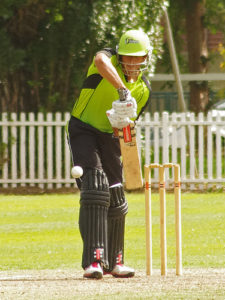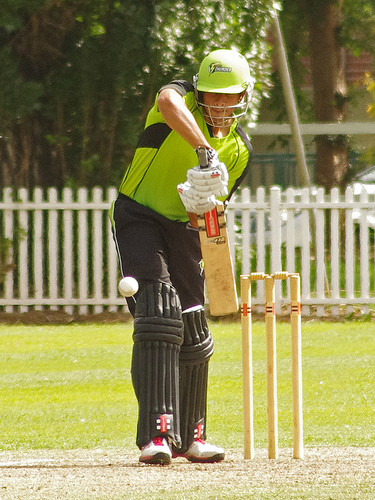Zeitungsdunkel
This week in Australia, many of us would have been following a very public selection process and would have no doubt mused over the advantages of left and right combinations, level of commitment and personal integrity, and the ability to survive through a sustained and unrelenting spin attack. But enough about the US elections, let’s talk about cricket.
Cricket in Australia is a well known summer institution. We have an almighty team filled with almighty heroes and we, as dedicated fans, check the score constantly with almighty expectations. Of course, often these almighty expectations are often supported by almighty predictions given to us from well respected members of the media, and the internal establishment itself, all of which we are completely happy to accept as hard truth right up until the moment the results go all pear-shaped. Then out come the cries of horror, outrage and the demands that the system be completely changed to avoid such a result ever reoccurring. But again enough about the US elections.
Part of the problem seems to lie in the fact that many Australian fans are fans of Australian Cricket and not followers of the game as a whole. Hence for them the only series that matter are the Australian home test matches every summer – because summer wouldn’t be summer without test cricket – and the away Ashes – because Poms. Away series like the recent trip to Sri Lanka where the hosts handed out a 3-0 test match butt kicking are either forgotten, smoothed over by the following One Day success or not even known about in the first place.
Followers of the game as a whole would be aware of this series, as of the various test series being conducted by the other nations. Overall form, or lack of, is noted.
So followers of the game are probably not remotely surprised by the recent test win by South Africa in Perth, while followers of Australian cricket are instead deeply scarred, openly questioning the selection process and grumbling loudly about various players being ignored by and/or retained in the test squad.
Not all the blame must go towards the participants however. Much of it also needs to be firmly heaped on the shoulders of the media for shamelessly concentrating on the wrong issues and hence giving the public the wrong information, but again enough about the US elections.
 For a prime example of this cricket deflection from reality your author would like to refer to an online source from ESPN Cricinfo and a pre-test opinion column that, while largely about South Africa, was matched with a smiling picture of Usman Khawaja.
For a prime example of this cricket deflection from reality your author would like to refer to an online source from ESPN Cricinfo and a pre-test opinion column that, while largely about South Africa, was matched with a smiling picture of Usman Khawaja.
Now before we continue we should establish that Usman, opinions on current form notwithstanding, is easily one of the top 50 cricketers in Australia. Your author, by comparison, is easily one of the top 23,015,050 cricketers in Australia and is only currently rated so high because the six-year-old down the road has recently decided to concentrate on tennis. Khawaja is one of our top cricketers and maybe should or maybe shouldn’t be in the current test team based on his form, experience and skills. What he shouldn’t be in the squad for, and this has been what has been hinted at in the Cricinfo article, is because of the D word.
Diversity.
Should a player be picked for his exciting stroke play, for the stability he brings to the middle order batting, his brave and disciplined attempt to rescue a dying test hope on the final day after a first innings failure; or because he breaks the mold of cricket being for white Anglo-Saxons and makes some inner-city latte-lover feel warm about Cricket Australia’s progressive attitude?
The D word isn’t just an Australian issue. South Africa, while still holding the memory of a more overt recent ethnic history, clearly feels this is important. During the online commentary feed for this test, the performance of JP Duminy was deemed worthy of discussion by some of the public following a comment supporting his inclusion in the current South African team was posted by the moderators. The comment sung his praises over a lengthy paragraph before closing with what came across as the definitive closing argument. He was also a person of colour.
Of course. Because that was all that mattered. Duminy, 37 tests, 1677 runs, high score of 166 and 38 test wickets. Currently with a career averaging a not outstanding 34.22, but currently averaging 50.8 from his most recent 2016 test series, which is a little bit better than, say, the 35.125 Steve Smith is averaging for the same period. Can we talk about his skills, form, abilities and how he is an internationally rated sporting star? Apparently not.
The issue can be further opened for discussion by considering some of the other test playing nations. Seen any Caucasians suiting up in the Bangladesh XI lately? Sri Lanka? Bangladesh rolled England only last month (something the Australian team would be currently not backed to pull off) and Sri Lanka clearly had no problem in their 3-0 home success. Should they be revising their selection policies to ensure an equal and representative mix of players? Or should they select based on the best squad available.
Cricket at test level is a profession. Spreading the game into new and previously non-traditional areas is a worthy and valid goal. Growth is only going to make the game better and stronger. Yet this is grass roots, and at the top the national team is expected to win.
Winning at anything, not just sport but life, business and (dare your author suggest it) politics, is greatly helped by managing to put together the best team possible. The world stopped being fair in the U-8’s ‘everyone gets a trophy’ competition and the AFL inclusion round. It is instead filled with competitors who want or need to be better than you, and that leads us to the big question of what you feel is more important:
Warm, Safe Zoned and Moral, or Professional and Successful?
Second Test starts November 12th in Hobart.
Photo by NAPARAZZI 










